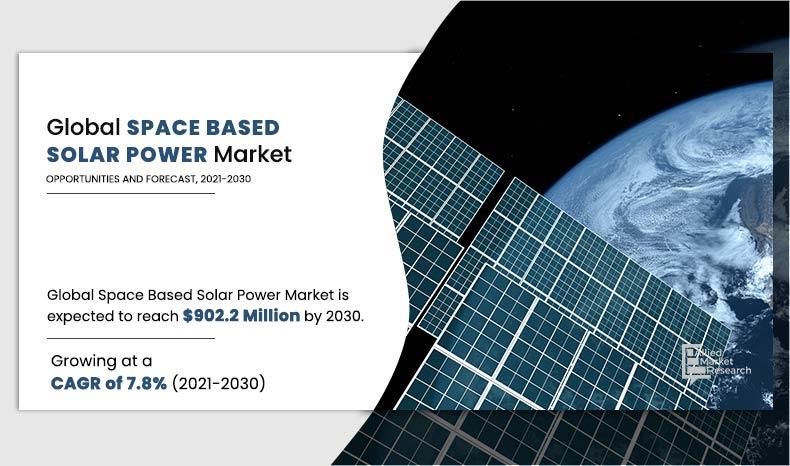
Space-Based Solar Power Market Projected to Hit $902.2 million by 2030
space-based solar power market
The growth of the global space-based solar power market is propelled by the implementation of strict government regulations concerning environmental pollution.
PORTLAND, OREGON, UNITED STATES, November 15, 2021 /EINPresswire.com / -- The space-based solar power market size was valued at $425.7 million in 2020, and is projected to reach $902.2 million by 2030, growing at a CAGR of 7.8% from 2021 to 2030. Space-based solar power generation involves the use of solar power generation system, which requires solar panels in space to produce solar power and transmit it to earth using microwave and laser transmitting satellite systems. Multiple benefits have been associated with space-based solar power such as it helps in generation of clean baseload electricity, does not emit nuclear radiations, and does not cooling systems.
Significant development of the end-use industries such as chemical, mining, manufacturing, construction, and automotive propels the demand for electricity, which, in turn, is expected to drive the growth of the space-based solar power market, globally. In addition, surge in demand for power from space applications such as satellites and space vehicles notably contribute toward the growth of the market. However, high cost associated with launching, maintenance, and installation of space-based solar power systems is the key factor hampering the growth of the global space-based solar power market.
Download Sample Report:
Depending on the solar satellite type, the laser transmitting solar satellite segment garnered the largest share of about 53.97% in 2020, and is expected to maintain its dominance during the forecast period. This is attributed to increase in demand for space-based solar power systems for providing power for satellites during eclipse, for orbital transfer vehicles, for solar array on the moon, and for electricity generation.
On the basis of application, the electricity generation segment holds the largest share, in terms of revenue, and is expected to continue this trend during the forecast period, owing to rise in energy demand along with cleaner generation of electricity across the globe.
Region wise, the market is analyzed across North America, Europe, Asia-Pacific, and LAMEA. Asia-Pacific was the largest share contributor in 2020, and is anticipated lead during the forecast period, due to increase in investment & R&D toward space-based solar power and presence of large consumer base in the region.
In addition, China and India have emerged as key hubs for space missions and solar power generation, thereby propelling the growth of the Asia-Pacific space-based solar power market from 2021 to 2030. Moreover, rise in awareness toward solar energy and its benefits in extracting solar power from space rather than earth-based solar power is expected to drive the growth of market in Asia-Pacific.
The global market analysis covers in-depth information of the major space-based solar power industry participants. The key players operating and profiled in the report include Airborne, Azur Space Solar Power GmbH, CESI SpA, Fralock Innovative Materials Manufacturing & Automation, Japan Aerospace Exploration Agency, Northrop Grumman Corporation, Solaero Technologies Corporation, Solaren Corporation, SpaceTech GmbH, and the Boeing Company. Other players in the value chain include Solar Space Technologies, Space Canada Corporation, and DHV Technology and others.
The key players are adopting numerous strategies such as product launch, agreement, and business expansion to stay competitive in the space-based solar power market.
For Purchase Enquiry:
For instance, in May 2021, Northrop Grumman Corporation signed an agreement with Airbus Defense and Space for the design, develop, and produce 24 ship sets of solar arrays to support the OneSat satellite product line. The solar arrays will power the OneSat communication satellites in geosynchronous orbit.
In addition, in January 2021, Boeing signed an agreement with NASA to supply solar arrays for International Space Station (ISS). These new solar arrays will provide power supply to orbiting laboratory. The installation of these solar arrays will begin in 2021.
COVID-19 impact on the market
The outbreak of COVID-19 has negatively impacted various industries and countries across the globe. Owing to the lockdown imposed, globally, decrease has been witnessed in the growth rate of the construction & building, transportation, oil & gas, automotive, and energy sectors. This has further declined the need for electricity, which, in turn, has hampered the growth of the space-based solar power market in 2020. In Europe, the economies such as Germany, France, Spain and, Italy are following stringent measures such as attaining social distance and limiting movements to prevent the spread of coronavirus.
Moreover, R&D activities were on hold due to shutdown of laboratories and incomplete funding. Thus, all these factors collectively are anticipated to result in sluggish growth of the global space-based solar power market in 2020. However, this situation is expected to improve as government has started relaxing norms around the world for resuming business activities.
Get detailed COVID-19 impact analysis on the Market:
David Correa
Allied Analytics LLP
+ +1 8007925285
email us here
Visit us on social media:
Facebook
Twitter
LinkedIn

Legal Disclaimer:
MENAFN provides the
information “as is” without warranty of any kind. We do not accept
any responsibility or liability for the accuracy, content, images,
videos, licenses, completeness, legality, or reliability of the information
contained in this article. If you have any complaints or copyright
issues related to this article, kindly contact the provider above.


















Comments
No comment